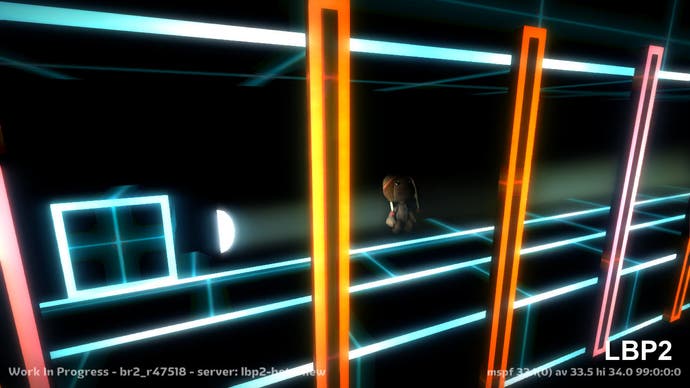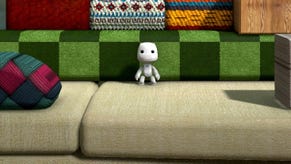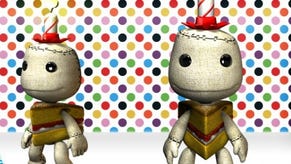Digital Foundry vs. LittleBigPlanet 2
The full story on Sony's closed beta.
Another big improvement in LBP2 is the improvement in volumetric, or foggy lighting. Volumetric lighting is lighting in fog or dust that you can see as a shape, such as god-rays through the clouds or trees, or a halo around a candle flame. LBP had a fogginess setting for lights to achieve this effect. In real life if you put an object in the light beam of a volumetric light, it stops the light passing beyond it, causing a shadow that stretches the length of the beam. LBP simulated this effect with a cheat that wasn't accurate, such that objects in front of a light as you are looking into the screen cast stronger shadows than objects actually in the light. You can see this in the screenshot below, with the uprights casting shadows even though they are not in the light-beam.
LBP2's approach is far more accurate, actually working with the three dimensions of the level, so that object only cast shadows when they are blocking the light. And they do this at a high quality, with few visible artefacts. What's more, LBP2's lighting engine is 'universal' to the level, so that every light is foggy to some degree and casting volumetric shadows, all the time. This creates great atmosphere, giving creators the chance to play with light more like Hollywood directors and their use of fog and smoke.
Other special effects are also equally impressive: for example, the clouds are volumetric, puffy and feature very convincing shadows. One thing we did notice though is that the draw distance is noticeably more limited than it was in LBP1, which explains why clouds disappeared in one of our custom levels.
The new "Splat" effect in LBP2 is excellent too. Media Molecule appears to have implemented a special effect buffer with its fluid dynamic applied, and when you destroy an object, it gets mixed in with the current buffer contents. Create a toxic cloud, put in an object and then dissolve it, and its cloud gets mixed in with the toxic cloud's turbulence.




Splat an object from above into the cloud and its particles receive turbulence. Splat particles also move in three dimensions, so these look more sophisticated than LBP's fluid effects. Fireballs are far more scary up against the wispy flames of the original, although the flickering fire effect isn't as good. LBP1 got the sense of 'a small flame viewed up close' absolutely spot on.
If there's one sad loss from the original game, it's the beautiful object motion blur: in the sequel, scenery and objects are rendered with a more clinical precision. Instead of LBP1's motion blur, there's what you might call a surface blur that simulates the effect but only within the confines of the object itself.
So, the renderer for LittleBigPlanet 2 is hugely improved over the original game, and there's no doubt about it - you do see a multitude of improvements when you import your existing levels into the new game. It's a very cool feature but we have a number of concerns about it. Firstly, the level of backwards compatibility in the beta is pretty questionable and in several of our own stages the gameplay mechanics are fundamentally broken when ported into LBP2.


A dancing level we have has light mechanics that never start. A black and white stage suddenly has coloured gas and fire effects, while the global illumination added to the sequel can break the visual look of levels built with a very specific lighting balance. A water effect crafted using glass no longer works as the glass pieces are clearly visible, and it seems that fog can no longer be black, meaning a mysterious-looking cave now has completely out-of-place puffy clouds instead.
Chances are that a great deal of the original content will work, and will look better, but a decent percentage of levels will need to be retooled. And the question then is, why bother? The next-generation creation tools in LBP2 are so far beyond what we had to play with in the original that adventurous creators will have little interest in tweaking their existing work - the possibilities inherent in the new tools are just irresistible.
And this is perhaps one of the most important things to take from the beta. While the backwards compatibility support is a nice touch, and allows us to highlight some of the improvements made to the rendering tech, the scope of content creation in the new game is simply staggering. It's difficult to describe in mere words why this is the case when the tools just demand that you dive in and get building. However, we've pinpointed three major advances that set the sequel apart from its predecessor.
The first is that parameters that were baked into materials and objects have now been opened up into components. For example, you are no longer limited to using glass for a slippery surface. Instead you can make any object slippery. In LBP1 if you wanted something to disappear, you either had to use the Dissolve material or apply a creature brain and terminate the creature. Now you can disintegrate any object with an attached component, freeing up a lot of the constraints of the original.
You can also set up movements without having to physically connect objects up to surfaces with pistons and string, although that clearly loses a little charm from the original. Microchips further tidy things up and improve creative use of components, because you aren't limited to trying to find room on your object to fit on another sensor or tiny little spring mechanism. This also means you no longer need creature brains for any object actions, and can create heat-seeking missiles or auto-targeting pie-guns and bats that'll buzz round Sackboy's head.
Another important change to LittleBigPlanet is that as a physics-based game it was surprising to see bounce absent. In LBP2, bounciness is a material parameter you can tweak, so basketballs and footballs for example behave more realistically.















